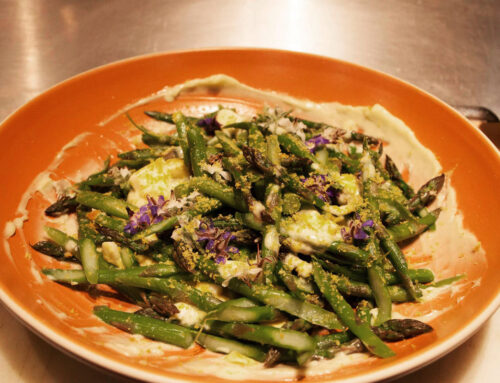EVENT DATE: JULY 7, 2015
The region and its flavors
The Italian Riviera, Liguria, is a mountainous stretch that frames the Mediterranean Sea in Northwest Italy. Before tourists flocked to its most famous destination—Cinque Terre—residents traditionally subsisted on fishing, and producing olive oil, wheat, grapes, wild mushrooms, artichokes, greens, herbs, some cheese, fruit, nuts, and chickpeas. Liguria’s bounty expanded when Christopher Columbus returned to his home here in 1492, with potatoes, tomatoes, sweet and hot peppers, more beans, corn, squash, zucchini, pumpkin, turkey, and cocoa. Although they were among the foremost spice traders, Ligurians, unlike Venetians, used minimal spice in their cooking, preferring to use herbs. Dry and fresh foods intermingle here—with dry foods appreciated for their portability and durability, and fresh speaking of flavors and life.
Let’s explore the history of a few dishes from the menu…
Antipasti: Caponata Sea Biscuit Salad (Cappunadda )
Liguria provides a poorer catch for its fishermen than the Adriatic or Aegean Seas. Theirs is a humble fish, pesce assuro, like sardines and anchovies. However, tuna made its way to the Italian Riviera via the Republic of Genoa, which had fishing rights in a tuna-rich zone near Tunisia. Salt-cured tuna loin, mosciame, which I used for the caponata, was first seen in the Ligurian diet in the 1500’s, coming from the Kingdom of Sardinia, which at the time ruled the region. I served the caponata with hardtack crackers, an English war-time staple, which at first seemed out of place to me. After several nights digging through books and articles, I discovered its origin—Via Aurelia. One of the oldest routes in Europe, used by traders and soldiers alike, this ancient highway began in Rome, and passed through Liguria, Southern France, and Spain, ending at the English Channel. This eventually brought the hardtack cracker to Brit soldiers and others along the way.
Antipasti: Mussels Lerici Style (Muscoli alla maniera di Lerici)
Mortadella, which I used to stuff the mussels, is a staple in Northern Italy’s Emilia-Romagna region. However, this cured pork sausage found a stronghold in Liguria thanks to a deal. Emilia-Romagnan butchers used salt from Liguria’s port city La Spezia to cure their hams, and in return, Liguria received prosciutto and mortadella.
Secondo: Goat with Cannellini Beans (Capra con i fagioli)
While fish is common in the everyday Ligurian diet, for festive occasions, like our Bionda dinners, Ligurians traditionally wouldn’t eat fish. To celebrate a fisherman’s homecoming, holidays, and other momentous events, Ligurians ate food from the mountains, like goat, which on my menu was braised with Heirloom canellini beans.






